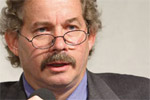Mongabay.com is partnering with the Skoll Foundation ahead of the Skoll World Forum on Social Entrepreneurship to bring a series of perspectives that aim to answer the question: how do we feed the world and still address the drivers of deforestation?
|
HOW DO WE FEED THE WORLD AND STILL ADDRESS THE DRIVERS OF DEFORESTATION? Soy, cattle, rice, palm oil, and logging are the principal drivers of deforestation. As global population increases from 7 billion to 9 billion by 2040, and as more and more people around the world rise out of poverty into the middle class, the demand for these commodities and practices will continue to rise with them. To address these issues, and in advance of the World Forests Summit hosted by the Economist in March, the Skoll World Forum on Social Entrepreneurship partnered with the Stanford Institute for the Environment and Mongabay News to surface the latest insights and innovations at the intersection of deforestation and sustainability. This debate will also set the stage for a larger discussion on deforestation at this year’s Skoll World Forum in Oxford, UK. |
During the 2013 SuperBowl, the championship game of the US National Football League, a truck company aired an advertisement that likened farmers to God’s favorite assistant. It suggested that when God needs something tough, or gentle, done, he calls a farmer. The narration, taken from a speech given to the Future Farmers of America in 1978 by Paul Harvey, a radio host, plays directly to the near mythical stature of farmers and ranchers in American culture and their deep connection to nature.
This is not news to anyone. Americans love their farmers. They love the image of the hardscrabble individualist epitomizing all that is good about America. They love the freedom and pioneer spirit ascribed to this life and to the taming of the West—Go West young man, and all that. And they are right. It is a worthy ideal.
But one needs to only watch a cowboy movie to understand that the taming of the US frontier was born of a massive land grab by characters wearing White and Black hats—or both, or one then the other depending on the plot. Let us also make note that settlement came at the expense of huge swaths of native forest and not inconsiderable damage to native populations. The point is that while Americans hold their farmers and the farming life dear, there is a complex call and response between economics and farming that defines the landscape, for better or worse.

|
But what of Brazil, a country of comparable size and production—as well as a similar path in frontier development—how do we view their farmers and ranchers? Well, from afar we mostly hold their feet to the fire as the demons responsible for deforestation. But reality is not quite so simple. One quarter of the land, more than 100 million ha, in the Brazilian Amazon is now privately owned. There are more than 500,000 families formally settled by the Government, each with approximately 100 ha, and probably that number again squatting to establish de facto tenure. In comparison, the US homestead act, active between 1862 and 1934, which had the same objective, granted 108 million ha in land to new owners. There are also thousands upon thousands of economic migrants seeking land for farming or ranching as the basis of a better future. And they are supported and encouraged, though not always efficiently, by the Brazilian Government through subsidized loans, infrastructure investments and social services–as they have been for decades–first in Southern, then Central and now into Northern Brazil. They are interchangeable with the American Pioneer and they are heading Northwest, young man.
 Frank Merry Financial Director, Aliança da Terra Frank Merry is Financial Director at Aliança da Terra, a Brazilian non-profit that promotes good land management. The 400+ farmers and ranchers working in partnership with Aliança da Terra manage more than 3 million ha and have invested more than $ 15 million in environmental recovery and social improvements in the past 3 years. |
“If we want to conserve the vast, and increasing, forest in private ownership we have to make it a valuable commodity—-one comparable to the alternatives or worthy of investment.”
Just as the reality of American farming does not exactly match the ideal, the Brazilian reality does not match the demonizing. There are many good guys battling amongst the rapacious sheriffs, world-weary saloon owners, well-heeled scoundrels, and dirty politicians. Indeed, Brazilian frontier migrants respond to the same economic calls as US farmers, past and present. The difference is that they face an economic reality today more akin to the past than the present where law and order is tenuous and where overall incentives still favor deforestation over conservation. So, where is the forest conserving Cavalry? Now that there is significant help from satellite monitoring, some better enforcement in place and huge gains in protected areas, we don’t have to look far, not past our pocket books, for the final piece of the puzzle.
If we want to conserve the vast, and increasing, forest in private ownership we have to make it a valuable commodity—one comparable to the alternatives or worthy of investment. Not an easy task in a place when agricultural land can be 10 times more valuable than forest. This money must flow directly into the hands of the landowner and not only be available through over-engineered schemes to reduce CO2 emissions or by forcing downstream conservation through actors beyond the farm gate. We must stop demonizing Brazilian farmers and ranchers while at the same time insisting these very same demons pay the cost of their own salvation. Make no mistake, farmers and ranchers will pay their part, but they need us on their side.
To discuss this commentary, please visit Put a price on it
|
ALL POSTS IN THIS SERIES
Can we meet rising food demand and save forests? (04/03/2013) A few weeks ago the Skoll World Forum hosted an online debate on how increased global consumption can be balanced with sustainability. The debate asks how a rapidly growing world that is ever consuming can hope to feed everyone, and at the same time address the deforestation that is emitting massive amounts of carbon into the atmosphere and destroying the world’s greatest tropical forests. Many contributors made very strong points—even contradicting one another in their approaches and ideas. Strong ‘no deforestation’ commitments save forests and feed people (03/12/2013) As a global community, we have so far failed to answer this most pressing question; we have yet to build our cloud. Deforestation rates are down in some places, but overall, our forests continue to disappear much as they have for the past 50 years, driven principally by increasing global demand for food. Can we feed the world and save our forests? Yes, we can, and the solution lies in the global supply chain and the message some companies are now sending their suppliers: ‘If you cut down trees, I won’t buy your product.’ This has the power to silence bulldozers. It’s already doing so and now it’s time to go to scale. The need to jump-start REDD to save forests (03/08/2013) At least US$7.3 billion has been pledged for REDD+ over the period from 2008 to 2015, with $4.3 billion pledged for REDD+ readiness during the fast-start period alone (2010-2012). In addition to these funds, private investors, private foundations, and others have been channeling financial support to developing countries for REDD+ and related programs for several years now. A promising initiative to address deforestation in Brazil at the local level (03/05/2013) The history of the Brazilian Amazon has long been marked by deforestation and degradation. Until recently the situation has been considered out of control. Then, in 2004, the Brazilian government launched an ambitious program to combat deforestation. Public pressure—both national and international—was one of the reasons that motivated the government to act. Another reason was that in 2004, deforestation contributed to more than 55 percent of Brazil’s total greenhouse gas emissions, making Brazil the fourth-largest greenhouse gas emitter in the world. Saving forests by putting a price on them (03/04/2013) During the 2013 SuperBowl, the championship game of the US National Football League, a truck company aired an advertisement that likened farmers to God’s favorite assistant. It suggested that when God needs something tough, or gentle, done, he calls a farmer. The narration, taken from a speech given to the Future Farmers of America in 1978 by Paul Harvey, a radio host, plays directly to the near mythical stature of farmers and ranchers in American culture and their deep connection to nature. Saving forests by stemming agricultural sprawl (03/01/2013) I’m fortunate to travel the world helping conserve habitats for some of the world’s most iconic species. When I visit places like the Amazon and Sumatra, I’m still awestruck by their diversity and pristine beauty. I’m also reminded how threatened they are. Our growing demand for food and fiber is fueling deforestation in resource-rich regions of the world. As environmentalists, if we don’t change where and how we produce food and fiber, we can turn off the lights and go home. There won’t be any biodiversity left to protect. Can saving forests help feed the world? (02/28/2013) As world population climbs from 7 to a projected 9 billion people and emerging and developing economies demand ever more of the food and fiber that drive deforestation, many environmentalists ask with increasing urgency whether and how tropical forests can survive. But the question may actually be whether and how the world’s increasing, and increasingly rich, population can be fed unless tropical forests survive. The challenge of putting Brazil’s forests in good hands (02/28/2013) People often associate Brazil with its forests. It’s no wonder given that nearly 60% of the country’s territory is covered by forest and it holds about one-third of the world’s remaining tropical rainforests. You might assume that a country like this would care about educating people to sustainably manage this precious heritage. Well, you’d be wrong! The corporate conservation revolution (02/27/2013) There’s a new kind of environmental hero emerging. They don’t live in Washington, D.C., and they’re known more for their interest in increasing earnings than in reducing greenhouse gases. They are found in an unlikely place: The Corporate Boardroom, and they’re making a big difference in saving the worlds forests and our climate. In recent years, a group of visionary corporate leaders have been quietly teaming up with a growing number of environmental groups to take a hard look at what’s left of our planet’s natural resources. Together, they agree: we are past the point where our land and oceans can meet the food, energy and commodity demands of our planet’s seven billion inhabitants. |
Editor’s note: The opinions expressed in this op-ed do not necessarily reflect the views of Mongabay.com or its staff. Mongabay founder, president, and editor Rhett A. Butler served as an advisor to the Skoll Foundation from 2010-2012.
Related articles








